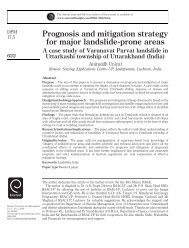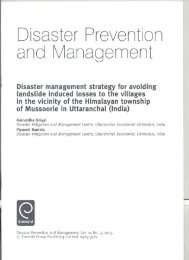Disaster management strategy for potential slide zones of Kumarkhera in Narendra Nagar township of Tehri Garhwal district, Uttarakhand, India
Disaster management strategy for potential slide zones of Kumarkhera in Narendra Nagar township of Tehri Garhwal district, Uttarakhand, India
Disaster management strategy for potential slide zones of Kumarkhera in Narendra Nagar township of Tehri Garhwal district, Uttarakhand, India
Create successful ePaper yourself
Turn your PDF publications into a flip-book with our unique Google optimized e-Paper software.
DPM<br />
19,3<br />
368<br />
<strong>in</strong>tervention <strong>in</strong> the <strong>for</strong>m <strong>of</strong> block<strong>in</strong>g or diversion <strong>of</strong> natural dra<strong>in</strong>age system and<br />
overload<strong>in</strong>g <strong>of</strong> hill slope (due to ill conceived construction <strong>of</strong> houses) when comb<strong>in</strong>ed<br />
with the cumulative effect <strong>of</strong> natural factors renders the area prone to <strong>potential</strong> mass<br />
wast<strong>in</strong>g activity <strong>in</strong> the future. Seismic shocks, heavy ra<strong>in</strong>s or prolonged spells <strong>of</strong><br />
ra<strong>in</strong>fall may suddenly trigger large-scale subsidence and <strong>slide</strong>s <strong>in</strong> this area. Immediate<br />
structural and non-structural mitigation measures should be under taken to avoid the<br />
risk posed to the small hamlet <strong>of</strong> <strong>Kumarkhera</strong>. Tehsil/Block <strong>Disaster</strong> Management<br />
committee, municipality and NGOs, should be <strong>in</strong>volved <strong>in</strong> sensitization and awareness<br />
creation <strong>in</strong> order to persuade the local population to desist from construction <strong>of</strong><br />
multistoried houses and rigorous cutt<strong>in</strong>g <strong>of</strong> slope <strong>for</strong> construction activity. Border<br />
Road Organization and Public Works Department can jo<strong>in</strong>tly <strong>in</strong>itiate structural<br />
mitigation measures <strong>in</strong> the area.<br />
References<br />
Brunsden, D. and Jones, D.K.C. (1984), “The geomorphology <strong>of</strong> high magnitude low frequency<br />
events <strong>in</strong> the Karakoram Mounta<strong>in</strong>s”, <strong>in</strong> Miller, K. (Ed.), International Karakoram Project,<br />
Cambridge University Press, Cambridge, MA, pp. 343-88.<br />
Ives, J.D. (1987), “The theory <strong>of</strong> Himalayan environmental degradation: its validity and<br />
application challenged by recent research”, Mounta<strong>in</strong> Research and Development, Vol. 7<br />
No. 3, pp. 189-99.<br />
Naithani, A.K., Prasad, C., Bist, M.P.S. and Kumari, G. (1997), “Land<strong>slide</strong> zonation and<br />
geo-environmental appraisal along Ma<strong>in</strong> Central Thrust zone <strong>in</strong> Mandak<strong>in</strong>i valley”,<br />
<strong>Garhwal</strong> Himalaya, <strong>India</strong>, Himalayan Geology, Vol. 18, pp. 135-43.<br />
Owen, L.A. (1991), “Mass movement deposits <strong>in</strong> the Karakoram Mounta<strong>in</strong>: their sedimentary<br />
characteristic, recognition and role <strong>in</strong> Karakoram land<strong>for</strong>m evolution, Z”, Geomorphol,<br />
Vol. 35 No. 4, pp. 401-24.<br />
Owen, L.A., Sharma, M. and Bigwood, R. (1996), “Landscape modification and geo-morphological<br />
consequences <strong>of</strong> the 20 October 1991 earthquake and the July-August 1992 monsoon <strong>in</strong> the<br />
<strong>Garhwal</strong> Himalaya”, Z. Geomorphol, Vol. 103, pp. 359-72.<br />
Owen, L.A., Benn, D.L., Derbyshire, E., Evans, D.J.A., Mitchell, W.A., Thompson, D., Richardson, S.,<br />
Lloyd, M. and Holden, C. (1995), “The geomorphology and landscape evolution <strong>of</strong> the<br />
Lahul Himalaya, Northern <strong>India</strong>”, Z. Geomorphol, Vol. 39, pp. 145-74.<br />
Ra<strong>in</strong>a, B.N. (1978), “A review <strong>of</strong> stratigraphy and structure <strong>of</strong> lesser Himalaya <strong>of</strong> Uttar Pradesh<br />
and Himanchal Pradesh”, <strong>in</strong> Saklani, P.S. (Ed.), Tectonic Geology <strong>of</strong> the Himalaya, Today<br />
and Tomorrow’s Pr<strong>in</strong>ters and Publishers, New Delhi, pp. 79-112.<br />
Thakur, V.C. (2004), “Active tectonics <strong>of</strong> Himalayan frontal thrust and seismic hazard to Ganga<br />
Pla<strong>in</strong>”, Current Science, Vol. 86 No. 11, pp. 1554-9.<br />
Uniyal, A. (2004), “Land<strong>slide</strong>s at Karnaprayag: another Uttarkashi <strong>in</strong> the mak<strong>in</strong>g?”, Current<br />
Science, Vol. 87 No. 8, pp. 1031-3.<br />
Uniyal, A. (n.d.), “Prognosis and mitigation <strong>strategy</strong> <strong>for</strong> major land<strong>slide</strong> prone areas: a case study<br />
<strong>of</strong> Varunavat Parvat land<strong>slide</strong> <strong>in</strong> Uttarkashi <strong>township</strong> <strong>of</strong> <strong>Uttarakhand</strong> (<strong>India</strong>)”, <strong>Disaster</strong><br />
Prevention and Management: An International Journal.<br />
Uniyal, A. and Prasad, C. (2006), “<strong>Disaster</strong> <strong>management</strong> <strong>strategy</strong> <strong>for</strong> mass wast<strong>in</strong>g hazard prone<br />
Naitwar Bazar and surround<strong>in</strong>g areas <strong>in</strong> Upper Tons valley <strong>in</strong> Uttarkashi <strong>district</strong>,<br />
Uttaranchal (<strong>India</strong>)”, <strong>Disaster</strong> Prevention and Management: An International Journal,<br />
Vol. 15 No. 5, pp. 821-37.





